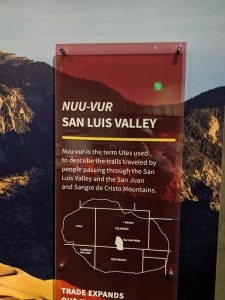In October, I was fortunate enough to take a weekend getaway to Denver, Colorado. As a fan of history, I took the opportunity to go to History Colorado, a major museum in the city that offers a glimpse into the history and culture of the former mining town. I was expecting to learn plenty about gold, mining and the Rocky Mountains, but to my surprise I was given the opportunity to learn about the Ute people and their language.
Ute is a language in the Uto-Aztec family spoken by about 1500 people today. The Ute people, although generally associated with Colorado and the surrounding area, are where we get the name Utah from. Although we use the term Ute, derived from a Spanish word, the Ute people refer to their language as núuchi, or “the people’s language.”
Ute contains 5 vowels and 13 consonants, and all Ute words must begin with a consonant and contain at least one stressed vowel. An interesting feature of the nouns of Ute is that they nearly all contain suffixes, which can indicate anything from inanimate objects to being a body part to plurality.
Even more fascinating is the preservation of the language. I was fortunate enough to speak with Liz King of History Colorado, who informed me that the Southern Ute tribe of Colorado has been working closely with linguist Tom Givon to create a dictionary of the language; this collaboration has also led to the exhibit in History Colorado tracing the history and influence of the Ute people that incorporates the language to show exhibit viewers the names of many famous Coloradan landmarks before the arrival of the Spanish. As mentioned, although there are only 1500 speakers today, the Ute believe that language is a gift from the Creator, and that its preservation contains not only important cultural significance but also spiritual.

In the Year of Indigenous Languages, it is great to see collaborations between local indigenous tribes and state governments to promote languages on the verge of extinction, and Ute provides a framework to keep the language and culture alive.
Further Reading and Sources:
https://www.culturalsurvival.org/publications/cultural-survival-quarterly/ute-language-policy
http://www.native-languages.org/ute.htm
